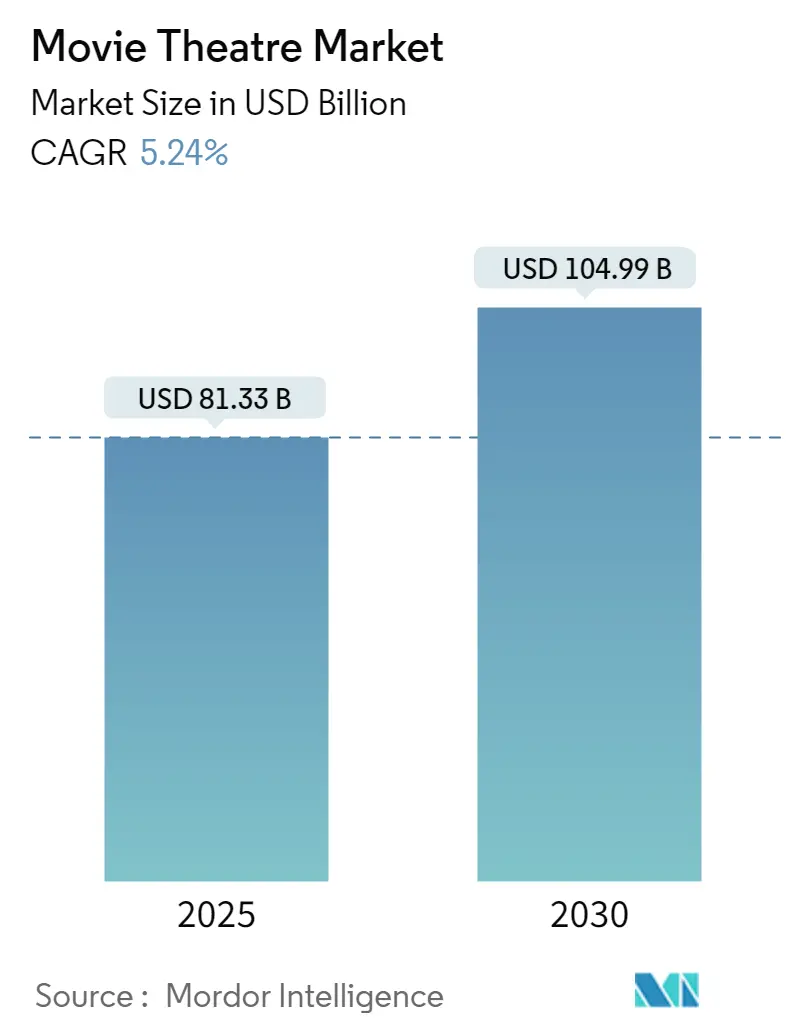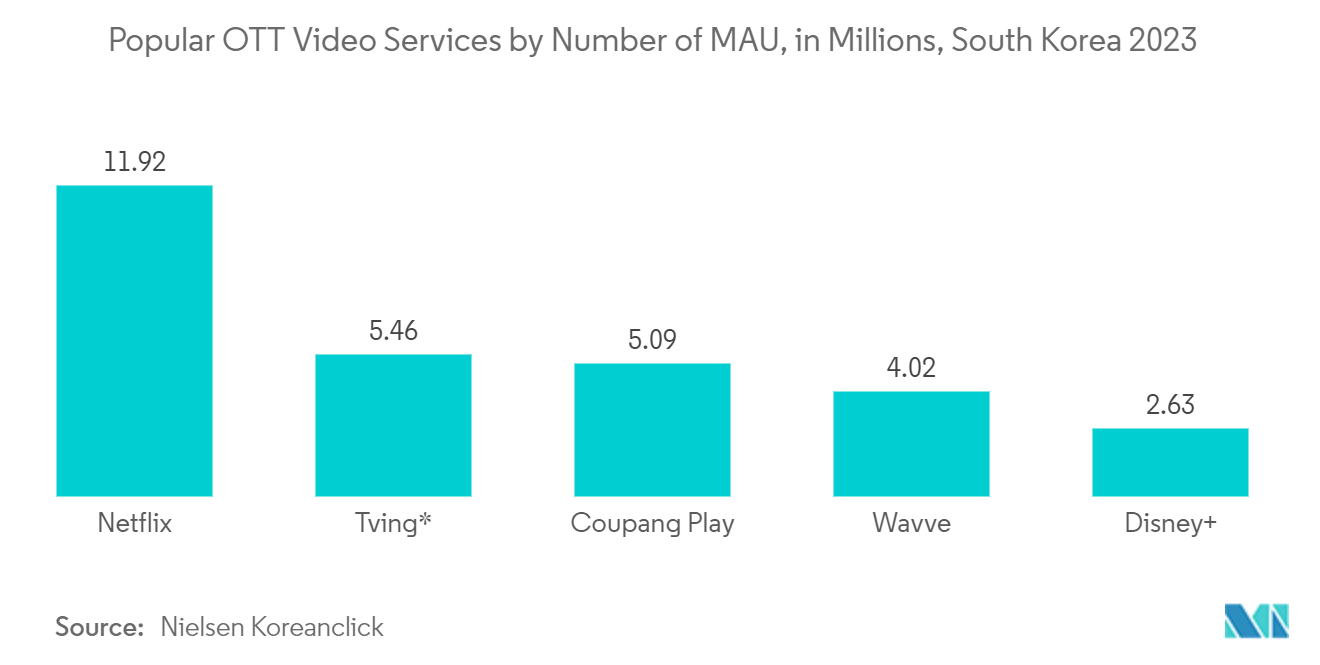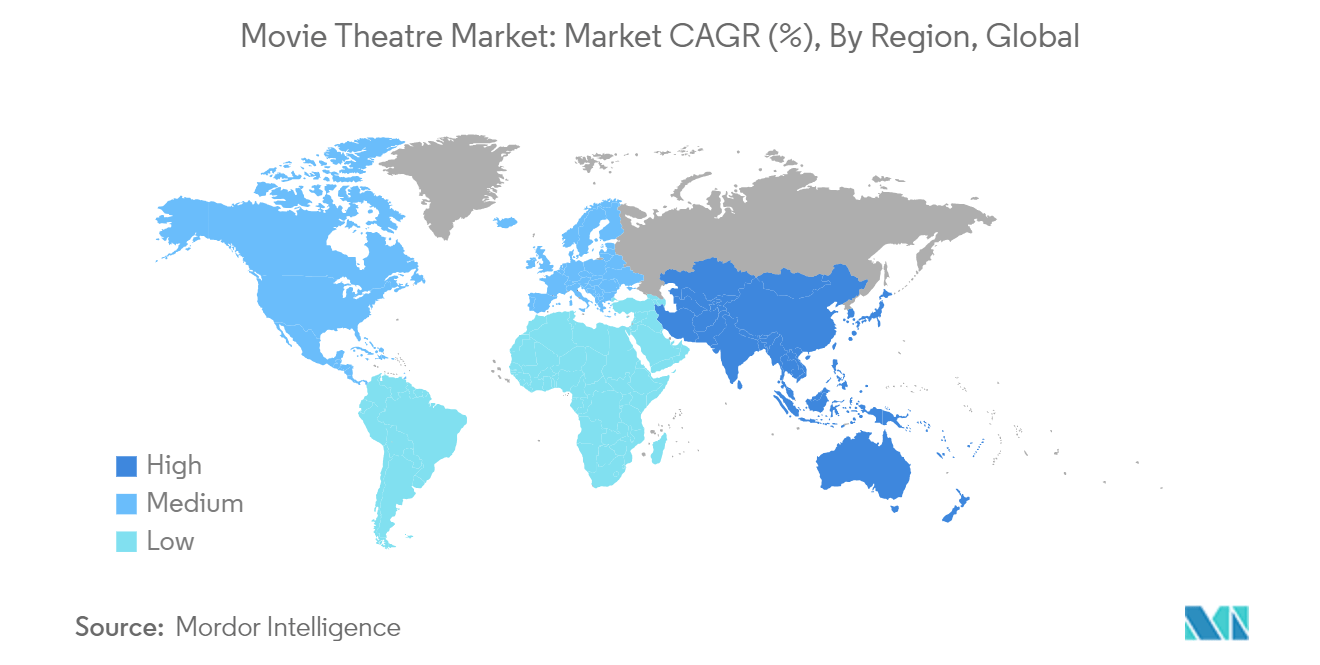
| Study Period | 2022 - 2030 |
| Market Size (2025) | USD 81.33 Billion |
| Market Size (2030) | USD 104.99 Billion |
| CAGR (2025 - 2030) | 5.24 % |
| Fastest Growing Market | Asia Pacific |
| Largest Market | North America |
| Market Concentration | High |
Major Players
*Disclaimer: Major Players sorted in no particular order |
Movie Theatre Market Analysis
The Movie Theatre Market size is estimated at USD 81.33 billion in 2025, and is expected to reach USD 104.99 billion by 2030, at a CAGR of 5.24% during the forecast period (2025-2030).
- The technological advancements and increased disposable income that support movie theaters in developed and developing regions are expected to fuel the growth of the overall market. A movie theater is a complex that is comprised of one or multiple auditoriums for watching movies intended for entertainment. These buildings are commercial and charge for tickets that allow people to watch movies in these theatres. Some theaters are owned and managed by nonprofit organizations with membership programs and charge a fee periodically to watch movies.
- Movie theaters project films on a large screen with sound, music, and perfect lighting for watching movies in the auditorium. The projection of movies may vary in form or quality, which includes 2D, 3D, IMAx or 4DX. Furthermore, multiplexes and buildings with multiple such auditoriums in a single building. This gives people options to watch movies at a single location. In recent years, the number of multiplexes has been on the rise, especially in developed and developing countries worldwide.
- However, Online streaming or OTT of movies and TV shows has increased in popularity in recent years, creating a severe danger to the film theater industry. The general public is progressively turning to these OTT platforms as they can deliver the viewers numerous films for a limited period and at the value of a single movie ticket. This is one of the most significant noteworthy challenges negatively affecting the movie theater market. Other problems and movie piracy are similarly anticipated to hamper the market growth globally.
Movie Theatre Market Trends
4DX segment is expected to grow at a higher pace
- The growing acceptance of 4DX multiplexes is primarily driven by the increasing demand for animation and visual effects (VFX) solutions. In the world of filmmaking, there is a noticeable upward trend in production budgets, largely due to the extensive global distribution made possible by digital theaters. Additionally, writers and directors are more open to incorporating scripts that require VFX, leading production companies to undertake ambitious projects that rely heavily on VFX and streamlined platforms. This has also resulted in an expansion of the types of content being distributed.
- The presence of 3D-UHD animated films in theaters, thanks to the application of VFX and animation in film, TV, and advertising, is on the rise. Outsourcing VFX approaches has become more prevalent due to its cost-effectiveness. Consequently, there is a growing emphasis on the "kids" genre, and the popularity of video streaming is expected to drive market demand in emerging economies.
- Modern-day artists require an array of tools and software to create captivating animated content that engages viewers. One notable trend in this regard is Virtual Reality (VR), which has gained significant popularity. More animation studios are incorporating virtual reality into 3D animation, taking the art form to new heights. Virtual reality has made it possible to experience 3D games in a virtual environment, thanks to the fusion of virtual reality and 3D animation.
- The integration of new over-the-top (OTT) services on subscription-based streaming devices in emerging economies is expected to boost the applications of the VFX and animation sector. Companies are actively exploring innovative services dedicated to energy and VFX for OTT content. For example, London-based DNEG has introduced a unique service called Redefine, aimed at bridging the creative services gap between the Western and Eastern markets for film and OTT streaming content.
- With the media sector's emergence, the demand for VFX and animation has expanded significantly within the multimedia ecosystem. Organizations like DNEG are seeking strategic investment partnerships to navigate these changes successfully. In 2022, DNEG inked a multiyear deal to expand its visual effects and virtual production services for Netflix series and feature programming until 2025. As part of this agreement, DNEG will produce content for Netflix and significantly enhance premium VFX services in both domestic and international markets for the streaming giant.

Asia- Pacific to hold the significant share
- Asia-Pacific has a large and rapidly growing population, resulting in a sizable consumer base for the movie theatre industry. The growing middle-class population and rising disposable income in Japan, China, India, South Korea & other South Asian countries have increased the demand for entertainment and leisure activities such as movie theatre experiences.
- Rapid urbanization in the region has created large metropolitan areas with dense populations, commercial establishments, and increased entertainment options. Urban centers cater to a large audience base and provide accessible access to cinemas, providing a favorable environment for the growth of movie theaters.
- In June 2023, The buzz surrounding the first-ever drive-in theatre in Hyderabad has been growing for quite some time, with movie enthusiasts eagerly anticipating its opening. It is arriving at the Rajiv Gandhi International Airport and has been reportedly named the 'Asian Classic.' According to the latest reports, the groundwork for the Asian Classic has been started. It will be constructed on 3 acres of land, which makes it the biggest-ever drive-in theatre in India. The concept of drive-in theatres, where audiences can enjoy films from the comfort of their cars, has gained popularity around the world, and now, Hyderabad is set to have its first-ever drive-in theatre at the RGIA soon.
- Further, in May 2023, leading multiplex operator PVR Pictures was renamed PVR INOX Pictures after a merger between PVR and Inox Leisure. PVR Pictures and Inox Leisure as a merged entity operating 361 cinemas with 1,689 screens across 115 cities till the end of FY23 in Sri Lanka and India. The operator also said that it had added 168 screens in the financial year 2023 between INOX (71 screens) and PVR (97 screens) and 79 screens added in Q4 FY'23 between INOX (26 screens) and PVR (53 screens). PVR INOX Pictures plans to increase investments in content acquisition for the Indian market and develop additional opportunities for under-represented storytellers and independent creators.
- In April 2023, CGV signed an exclusive contract to acquire hundreds of Christie CineLife+ series cinema projectors featuring some of the most energy-efficient luminance systems on the market for its multiplexes located in South Korea, China, Vietnam, and Indonesia over the next three years. With this acquisition, Christie will supply CGV - South Korea's largest cinema chain and the world's fifth-largest multiplex theatre company - with projection systems that bring advanced format capabilities to premium large-format venues and mainstream theatres.
- The rise in population and adoption of new technology in this field and the area's development are owing to the technology's deployment. With the region's advanced technology headquarters, this region will continue to be the leading market in the movie theatre market.

Movie Theatre Industry Overview
Competitive rivalry within the Movie Theatre market is intense, primarily driven by prominent industry leaders such as PVR INOX, Cinepolis, AMC Theatre, Regal Cinemas, and Wanda Cinema. These market giants enjoy a competitive edge through their consistent innovation in product offerings, as they proactively anticipate consumer needs. Their significant market share is a result of substantial investments, strategic mergers and acquisitions, and fruitful partnerships.
In September 2023, PVR INOX, India's foremost cinema exhibitor renowned for its exceptional quality, expanded its portfolio by introducing its state-of-the-art ICE THEATERS auditorium in Bangalore. This endeavor follows the successful launch of ICE THEATERS in Delhi and Gurugram, aimed at providing moviegoers with a luxurious and immersive cinematic experience.
In March 2023, Amazon made a significant announcement regarding its intention to acquire the world's largest movie theater chain, AMC. This strategic move comes as AMC Theater grapples with the growing popularity of over-the-top (OTT) platforms worldwide. Wedbush Securities, a U.S.-based financial firm, predicts that this acquisition will bolster the chain's market presence, aligning it more effectively with the contemporary entertainment landscape.
Movie Theatre Market Leaders
-
AMC Theatres
-
Cinépolis
-
PVR LTD
-
Regal Cinemas
-
Wanda Cinemas
- *Disclaimer: Major Players sorted in no particular order

Movie Theatre Market News
- August 2023: The Grammy-winning pop sensation Taylor Swift, fresh from unveiling the next chapter of her economy-boosting Eras Tour, made an exciting announcement. She revealed that the tour will be hitting North American theaters as a movie starting in October 2023. The esteemed theatre chain, AMC, has secured the rights to showcase this cinematic spectacle. Given the resounding success of the concert tour, expectations are high that the movie will enjoy a prosperous run in theaters, thereby significantly bolstering the revenue of AMC.
- May 2023: IMAX and Kinepolis proudly unveiled the expansion of their longstanding partnership. This expansion includes the addition of approximately eight new IMAX installations spanning both Europe and North America. The agreement encompasses four brand-new locations across Europe, including Belgium, France, and Spain, as well as the very first IMAX system in Luxembourg. Furthermore, it introduces a fresh IMAX destination in Ontario and Michigan, along with two state-of-the-art IMAX systems in Ontario.
Movie Theatre Industry Segmentation
A movie theatre has an auditorium where individuals can watch movies for amusement. Theatres are commercial facilities that cater to the general public and are available by ticket purchase. Some movie theatres are operated by non-profit organizations or institutions that charge members a fee to watch movies. Movies are cast onto a giant projection screen at the front of the cinema via a projector, and many wall-mounted speakers broadcast sound and music.
The movie theatre market is segmented by screen (2D, 3D, and 4DX), theatre type (multiplex, independent cinema theatres, IMAX, and drive-in cinema theatres), and geography (North America, Europe, Asia-Pacific, Latin America, and Middle East & Africa).
The market sizes and forecasts are provided in terms of value in USD for all the above segments.
Movie Theatre Market Research Faqs
How big is the Movie Theatre Market?
The Movie Theatre Market size is expected to reach USD 81.33 billion in 2025 and grow at a CAGR of 5.24% to reach USD 104.99 billion by 2030.
What is the current Movie Theatre Market size?
In 2025, the Movie Theatre Market size is expected to reach USD 81.33 billion.
Who are the key players in Movie Theatre Market?
AMC Theatres, Cinépolis, PVR LTD, Regal Cinemas and Wanda Cinemas are the major companies operating in the Movie Theatre Market.
Which is the fastest growing region in Movie Theatre Market?
Asia Pacific is estimated to grow at the highest CAGR over the forecast period (2025-2030).
Which region has the biggest share in Movie Theatre Market?
In 2025, the North America accounts for the largest market share in Movie Theatre Market.
What years does this Movie Theatre Market cover, and what was the market size in 2024?
In 2024, the Movie Theatre Market size was estimated at USD 77.07 billion. The report covers the Movie Theatre Market historical market size for years: 2022, 2023 and 2024. The report also forecasts the Movie Theatre Market size for years: 2025, 2026, 2027, 2028, 2029 and 2030.
Our Best Selling Reports
Movie Theatre Industry Report
Statistics for the 2025 Movie Theatre market share, size and revenue growth rate, created by Mordor Intelligence™ Industry Reports. Movie Theatre analysis includes a market forecast outlook for 2025 to 2030 and historical overview. Get a sample of this industry analysis as a free report PDF download.




